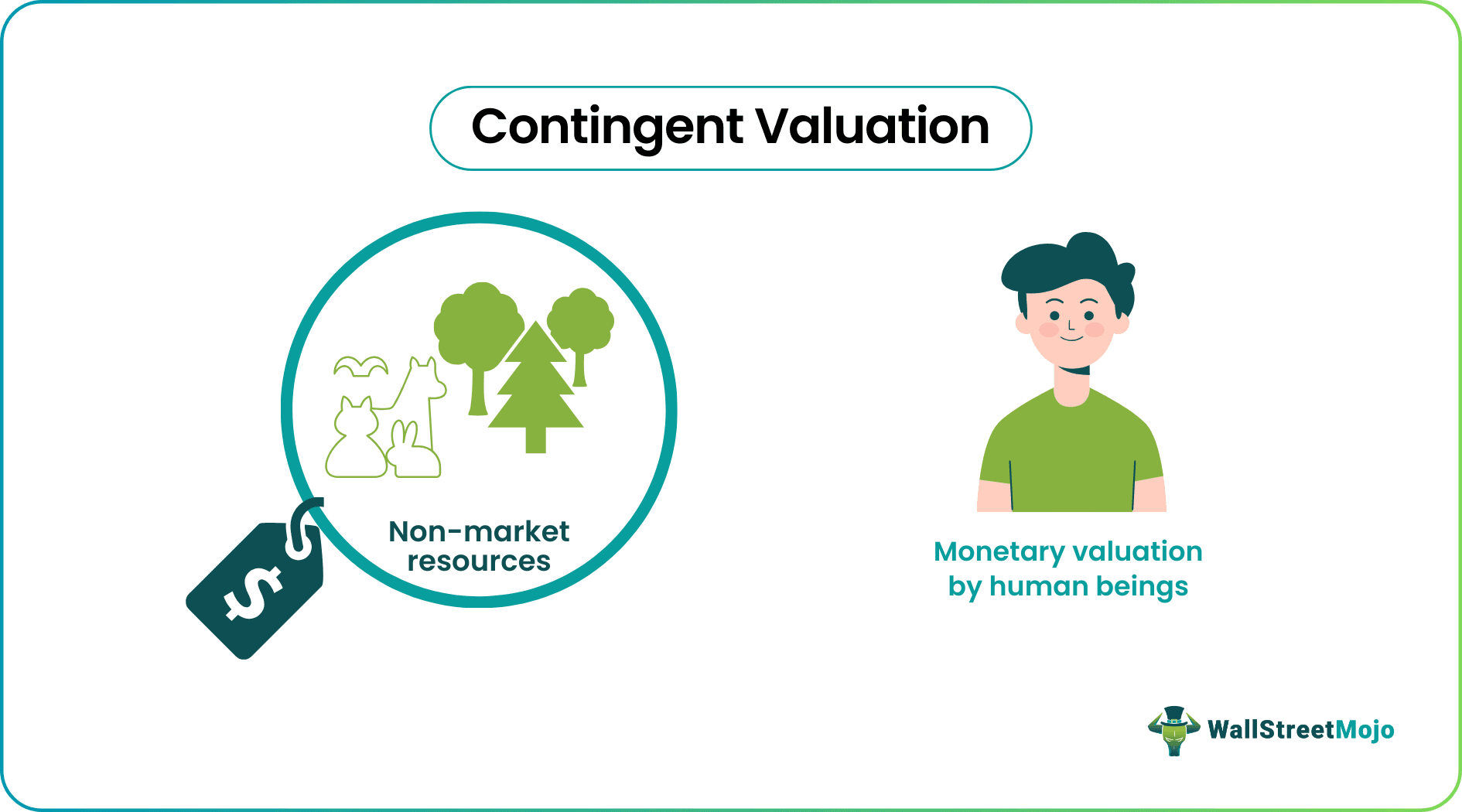Table Of Contents
What Is Contingent Valuation Method?
The contingent valuation method (CVM) is an economical technique that helps determine the monetary value of a non-market resource. Furthermore, the economic valuation of goods and services that cannot be sold or exchanged is a rather difficult process and might not yield satisfactory results. In essence, contingent valuation is a survey-based technique.

Natural resources like water, natural scenery, and mountains provide utility, but conventional pricing models cannot be applied to them. Therefore, their value is often determined by the willingness of respondents to pay for them as they see fit. However, the contingent valuation method has received criticism despite its usefulness in estimating the value of non-market resources.
Key Takeaways
- The contingent valuation method (CVM) is a survey-based technique that measures the economic value of public goods and services not traded in markets, such as clean air, natural parks, and cultural heritage.
- CVM provides policymakers with a way to assess the benefits of investing in public goods relative to their costs.
- CVM has been widely used in policy areas such as environmental protection, biodiversity conservation, and healthcare to estimate the economic value of public goods and services economic value and inform policy decisions.
Contingent Valuation Method Explained
The contingent valuation method (CVM) is a survey-based technique used to estimate the value of public goods and services not traded in markets, such as clean air, natural parks, and cultural heritage.
The method gained popularity in the late twentieth century when environmental economists started using it to measure the value of non-market environmental resources. Since then, CVM has become a widely used method for valuing public goods and services and has been applied to a wide range of issues, including climate change, biodiversity conservation, and health care.
The importance of CVM lies in its ability to measure the economic value of public goods and services, which can be used to influence and form public policy decisions. By measuring the willingness of individuals to pay for public goods or services, CVM provides policymakers with a way to assess the benefits of investing in public goods relative to their costs. This is particularly important for non-market environmental resources, whose economic value is not reflected in market prices.
Examples
Let's understand the concept of contingent valuation method with a few examples.
Example #1
City Q was the industrial hub of the country. Many factories operated in the city and often practiced negligent waste disposal, thus polluting the air and water. Due to constant protests by citizens and NGOs, the municipality decided to make the factories pay the cost of the damage done while simultaneously ordering them to implement environment-conscious waste disposal.
The citizens were supposed to elect a group of 1000 respondents for a contingent valuation survey. They were each asked five questions:
- How much would you pay for the river into which factories X, Y, and Z release the waste?
- How much should each of the factories, X, Y, and Z, pay every month for having disposed of their waste into the river as of today?
- What is the value of the air you inhale in a minute?
- How much should each factory A and B pay monthly for the air pollution they have caused yet?
- According to you, what is the value of City Q now, and what would be its value if none of the factories A, B, X, Y, and Z operated here?
Based on these responses, the municipality decided to demand compensation from these factories, which would be used to restore the environment.
Example #2
The world is currently facing a plethora of issues – political, financial, environmental, social, etc. But a recent study by the Intergovernmental Science-Policy Platform on Biodiversity and Ecosystem Services (IPBES) indicates that human beings' failure to go beyond economic valuations of natural resources is what is ruining the planet. The conclusion was based on 13,000 references.
Natural resources are often valued based on their utility to humans. The oxygen from trees, the effect of waterbodies on weather, etc. And then there are those schemes such as carbon offsetting, carbon tax, etc., that put a price tag on environmental degradation and pollution. While some argue that these measures are supposed to make people conscious of the damages, others argue that the result is mostly the opposite.
Advantages And Disadvantages
Here are the two sides of the contingent valuation method.
Advantages
- CVM helps determine the value of environmental resources and non-market goods by avoiding purely economic pricing models.
- Despite criticisms, it is the only reliable model to aid environmental evaluation.
- Since the survey includes a large enough sample population, it can represent the actual interests of the population.
- Lastly, given the pace of growth and the numerous environmental concerns arising, such an evaluation model is extremely beneficial.
Disadvantages
- Some of the problems with contingent valuation is that the responses recorded in a survey might not resemble the actual behavior or actions of the respondent.
- For the technique to be practical, it should be valued concerning income. That is, too often, people ignore their income constraints. Attributing too much value to a precious resource used daily might affect the scope of such an exercise.
- Since the model depends on human perceptions, it might be prone to bias, which can significantly impact results.
Contingent Valuation Method vs Hedonic Pricing
Let's look into the difference between contingent valuation and hedonic pricing.
- Hedonic pricing is a valuation model in which a product's internal features, characteristics, and external factors influence its price.
- It considers the customers' perception of how much money they would be willing to pay for a certain product given its environmental conditions or external atmosphere rather than just its inherent value.
- For example, consider a house that costs $280,000 to build. It is sold at a profit of $20,000, that is at $300,000. Now suppose the house is in a disaster-prone area or an unwelcome neighborhood. The seller might not be able to realize a profit of $20,000. However, if the house is in a friendly neighborhood with excellent accessibility and other amenities, the seller can sell at $300,000 or more!
- The only similarity between these two techniques is the willingness to pay factor. It depends on the customers' perception of how much a mountain costs or how valuable is a friendly neighborhood.
- The major difference is probably the type of resource. Hedonic pricing applies to goods that are sold in the market. Thus, it involves the product's inherent value and the intangible element attached to it. On the contrary, in a contingent valuation model, a non-market resource is valued purely based on intangibility.
- Hedonic pricing is way more flexible than contingent valuation since it can be determined greatly based on the cost of production, profits, etc. This is not possible with CVM.
- And, of course, let's not forget the taxes and other expenses that go into the valuation of hedonic pricing.

